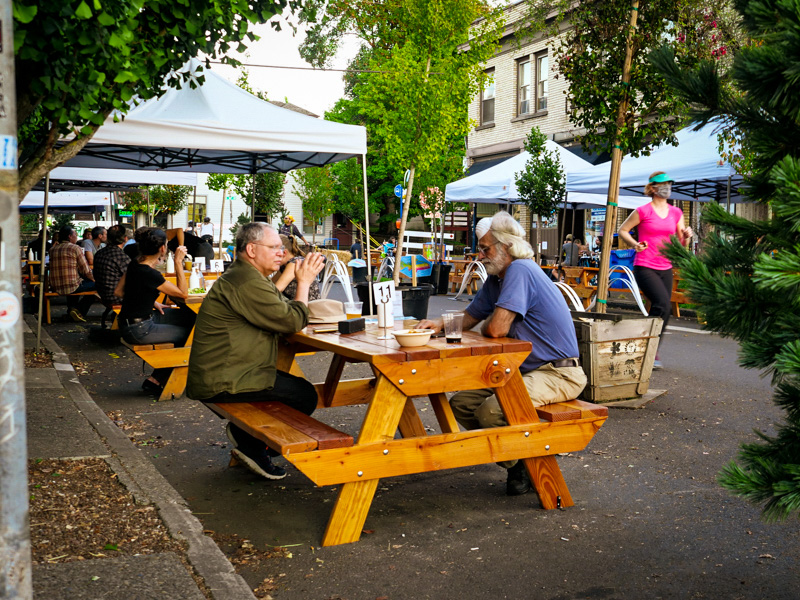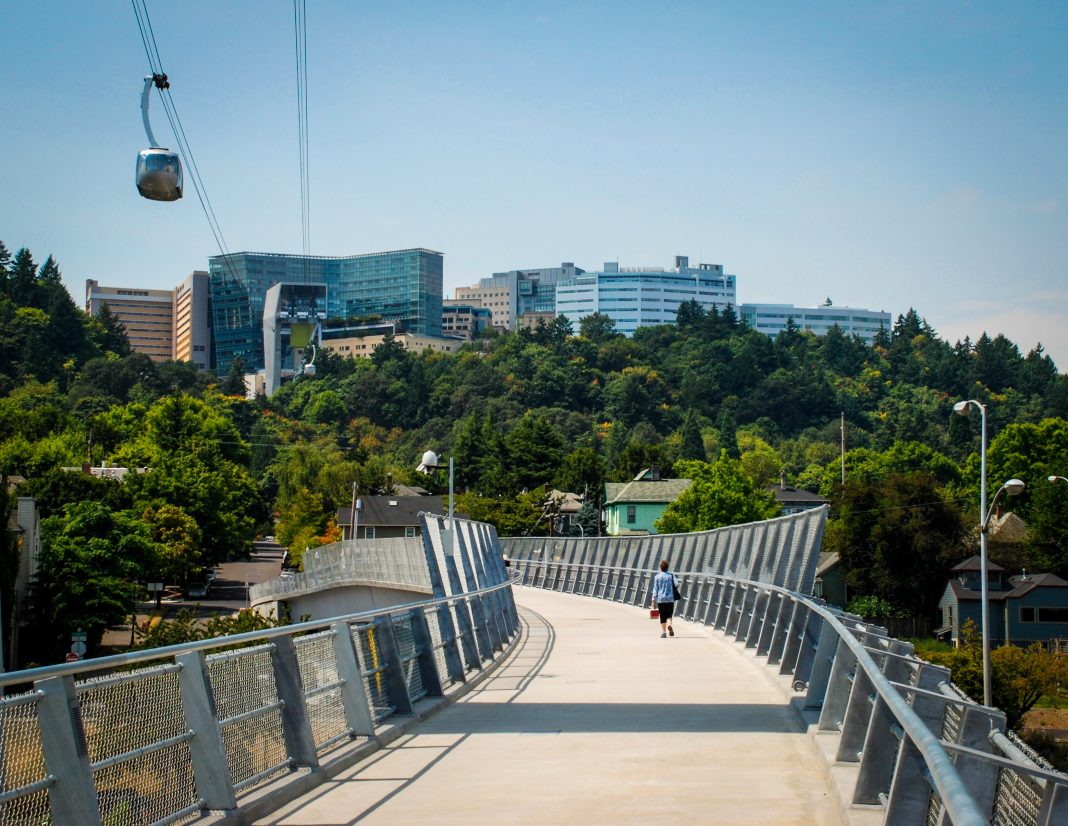With its first pedestrian plan having been published in 1998 and its recent update spanning over 300+ pages, Portland, Oregon is one of the cities spearheading walkability in the US. We sat down with Michelle Marx, Portland’s pedestrian coordinator, on lessons learned, challenges faced, and visions ahead.
You can’t really do research on walkable cities without coming across Portland. Roughly 20 years after publishing its first pedestrian plan in 1998, the PedPDX was released as a citywide update in 2019 – a hefty 300-page document, with two-thirds covering the Implementation Toolbox alone. After putting pedestrians first for more than two decades –What are the city’s walkability priorities? And what is it that we can take away from its efforts?
PedPDX in a Nutshell
With the vision of making Portland a great walking city for all, these are the key questions the pedestrian plan is dealing with:
- Safety: Being a Vision Zero city, one top priority is pedestrian safety. This means eliminating traffic-related deaths and serious injuries, and protecting people walking – currently, 31% of all traffic fatalities in Portland involve pedestrians.
- Equity: PedPDX tells us that inadequate pedestrian infrastructure and traffic safety concerns disproportionately impact low-income communities and people of colour. To become a city walkable for all, Portland is prioritising investment in areas with historic underinvestment (timeline and next steps transparently displayed in this online map).
- Liveability: Similar to cycling networks, Portland aims to provide a connected pedestrian network that supports walkable neighbourhoods and makes walking fun while connecting it to peoples’ daily needs
- Health: Establishing walking as an integral part of personal and individual health
So, what can we learn from 20 years of effort? With its urban fabric being rather similar to a lot of European cities, here are 5 lessons Michelle Marx, Portland’s pedestrian coordinator, shared with us:
Start With Walking, Don’t End With It
We’re all pedestrians – reason enough to put walking on the top of the transportation hierarchy. “The way we see it, walking is a foundational element to every other mode of transport. It really is the foundation of our transport system,” Michelle states right at the beginning of our interview. And she’s right – no matter if we drive our cars, use public transport, or ride our bicycle, we first walk to our bicycle, car, or transit stop. This means that walking comes first, not last in the transportation hierarchy as well – something that Portland has been building upon for more than two decades now. The equation seems to be a rather simple one at first sight: “There’s no way that we are going to get people out of their cars unless we have a walk-friendly city,” she says.
Still, it seems that in a lot of cities walking as a mode of transport stands in the shadow of almost all other mobility options you have. This might be a matter of political willpower, but also a matter of communication: there are so many benefits to walking, that it can be hard to pin down. Walking is connected to traffic safety, personal health, air pollution, and the liveability of cities, and as a topic with that many faces, it often still stays overlooked and underrated.
Making a city truly walkable requires efforts by multiple city departments; it calls for communication, collaboration, leadership, and someone coordinating all the before mentioned.
Back It Up With Political Leadership
How do you put pedestrians first and convince city leaders to invest time and money into walkability? First, it’s always good to argue with numbers. In Portland’s case, 31% of all traffic fatalities involve people walking, while pedestrian trips only account for 9% of all trips taken citywide. Being a Vision Zero city, the focus of making the city more walkable is dealing with traffic safety.
“As the political leadership is taking a very aggressive stance against traffic deaths, this is a way to argue when it comes to changing the configuration of a roadway, making it more difficult to drive, or making it slower to get from point A to point B in your car. It’s pretty hard to argue with – Hey, we want to make investments so that you can cross the street and not get killed,” Michelle points out.
To get started in your own city, find out what kind of arguments resonate with your local politicians and frame the topic accordingly. What’s on their current agenda, what kind of goals and numbers do they have to meet? How does your walkability concern fit into their plans?
Get Your Data Right, and Involve Citizens – All Citizens, That Is
For a lot of cities, data on pedestrian traffic flows is a scarce good. While there’s lots and lots of data on how many cars drive when and where for what amount of time (almost the same goes for bicycles), this isn’t the case for data on pedestrian movements. While trying to get a better pedestrian data collection, work with the data you (might) already have:
Find out where most pedestrian crashes occur to get a feeling for where to start. In Portland, for example, more than half of deadly crashes occur on 8% of the streets. Next, consider when crashes happen: do they occur seasonal or at a specific time of day? Do most of them appear at intersections, and if so, are these intersections signalised? This helps prioritize infrastructural improvements – be it better lightning, road maintenance, or signalling.
Another way to go about it is by identifying which neighbourhoods and streets have seen adequate investment, and which haven’t – and finding out how this relates to neighbourhood income levels. As for Portland, Michelle emphasizes “intentionally focusing investments on those underserved neighbourhoods,” with data showing how low-income neighbourhoods disproportionately suffer from traffic violence.
When it comes to involving citizens, pay attention to whose voices you’re hearing, and make sure to reach out to the more vulnerable groups as well. After releasing a community-wide survey, Portland compared the demographics of who they were hearing from with their city-wide demographics, only to realise that most of the respondents were wealthier, white, and living in the more privileged parts of town.
Setting up focus groups with non-white citizens is something Michelle recalls as an eye-opening experience: “The number one response we heard from black Portlanders by far was that a barrier to walking was poor lighting. That was a response that didn’t even pop up in the top 10 responses on our city-wide survey. This really stemmed from a lack of a sense of personal safety and security in a way.” As a result of hearing this, PBOT advanced in lightning improvements as a key action in their plan, but it’s something they would have never focused on if it wasn’t for the focus groups. And this learning went way beyond the pedestrian plan: “Seeing the difference in needs of our different residents has really changed the way we do business at the Bureau of Transportation in Portland. We’re doing a lot more very intentional, very focused outreach and engagement with our black community as a result”.
Be Transparent, and Don’t Fall Into Analysis Paralysis
The worst thing you could do when involving citizens is asking them for their opinion, only to completely ignore it in your further implementation plans. Portland went ahead and asked its residents about what the biggest barriers to walking in Portland are, and where the investment priorities should be – and turned the feedback into the walking plan’s core structure: “We’re really relying on that community feedback to show Portlanders what our collective priorities are,” Michelle states.
Another essential feature of their pedestrian plan is an online investment map that accompanies the plan: This is where they track all their data, showing in real-time where missing sidewalks and crosswalks are, and where they are intending to invest in the coming years. “Any resident in our city or elsewhere can go onto these maps and see where we’re investing and why, and where we have missing infrastructure and why,” she explains. “You know, sometimes plans can sit on a shelf and just be a 300-page reference document that nobody looks at – but what I think is going to be our plan’s success is this dynamic living breathing map that guides our actions.”
Convince Naysayers – and Traffic Engineers

Driving change in cities always comes with a fair share of opposition. When asked for advice, Michelle shared that one of the strategies that she’d recommend is trialling a temporary installation, like closing a street for a weekend or a week in summer: “Sometimes, once you try a temporary approach like that, people who oppose it figure that the sky didn’t fall down, and it was actually quite lovely.” It’s a chance to push comfort thresholds with the more oppositional residents while you’re moving forward.
Besides car-loving residents, another group that often still needs to be convinced is people working in engineering professions. Often enough, institutionalised traffic manuals dictating the width of roadways or distances between signals make driving comfortable and easy but walking and cycling difficult. That emphasizes the importance of communication when working on making a city more walkable – both with citizens, but also with partners and other departments of the city.
Michelle’s advice for CityChangers in the field is to find allies, focus on kids, and get across a personalised message to citizens – phrasing it as an individual imperative: “Get out, see your neighbours, get some exercise, move your body, experience the weather, and why that’s good for you as an individual”, she exemplifies. “After that, you can build on to why it’s good for us as a collective, too.”


